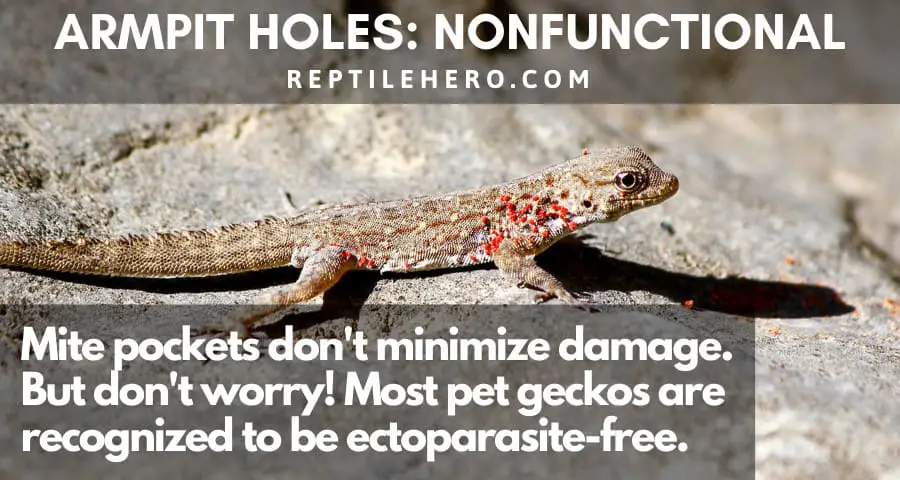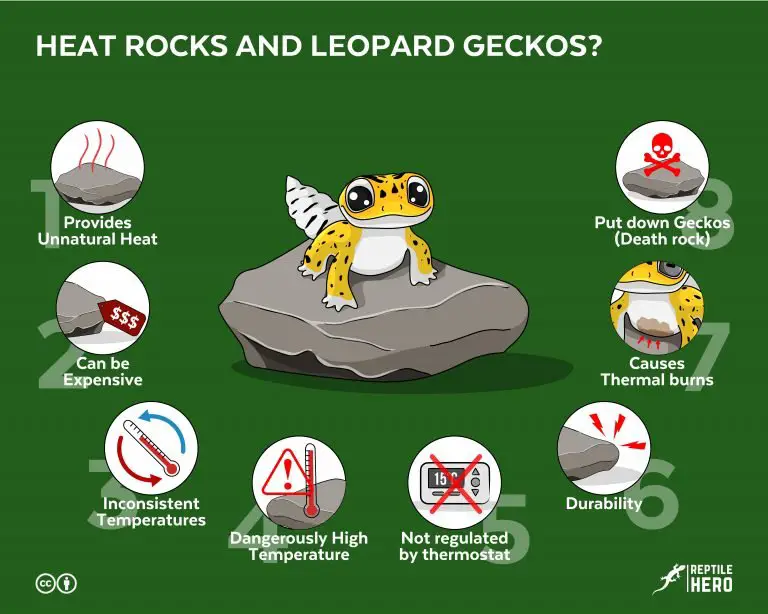Are Gecko Armpit Holes Normal? (What Are They For?)
Admiring the beauty of our leopard geckos up close is always a fun time—until you notice a curios hole in their armpit! In humans, that’s never a good thing. So does it mean that armpit holes are a bad sign for your gecko?
In general, leopard geckos normally have holes on either side of their upper bodies, right by their armpits. Most other gecko and lizard species also have one or more of these dermal cavities on their bodies. Experts are still uncertain of their exact function but they are not correlated with gecko’s health and quality of life.
Good news: you don’t have to cash out money to get your gecko’s armpit hole checked! But could they possibly affect your scaly babies’ life in any way? Read on to learn more!
Is It Normal for Geckos to Have Holes in Their Armpits?
It is normal for the average leopard gecko to have shallow holes in their front armpits. Commonly, these are not readily seen unless a gecko completely stretches out its forelimbs while being observed closely.
Most gecko owners, both new and old, are aware of the fact that leopard geckos have holes on either side of their heads. Those are our cute geckos’ ears!
But what about the other holes on their bodies? More specifically, what about the hollow pockets they have right under their forelimbs?
Quite honestly, I was quite surprised when I first noticed the holes right under my first-ever leopard gecko’s arms. It didn’t look like regular armpits so I was frankly worried. However, upon reading more into it, I realized that it wasn’t a bad thing at all!
Upon closer inspection, these tiny and shallow cavities that leopard geckos have, right behind and under either of their forelimbs, are not that different from the rest of their upper bodies—or even entire body, for that matter.
You won’t see exposed muscles in a gecko’s armpit pocket, just little scales that are a bit more irregular [1]. The color of the scales leos have in their pockets generally matches their overall coloration and pattern as well, which is highly dependent on their specific morph.
Learn more about the stunning looks of leopard geckos in our article on morphs.
In reality, the armpit holes of leopard geckos don’t really affect the quality of life they live. These pockets won’t give you any information about your gecko’s overall health either. So what’s their purpose? Well, I’ll tell you more about that in a later section of this article!
What is the proper term for the armpit holes of leopard geckos?
Colloquially referred to as mite pockets in the reptile-keeping community, the armpit holes of leopard geckos are called various names. More technical ad scientific terms used to refer to lizard armpit holes include acarinarium, skin invaginations, axial cavities, integumentary pockets, and axillary skin folds, among many others.
Why Do Some Geckos Have More Prominent Armpit Holes?
The skin folds of leopard geckos commonly referred to as armpit holes, or mite pockets, vary in size—only about a few millimeters in diameter and depth. As such, some geckos may have more prominent armpit holes at first glance.
Of course, there are other things to consider as well. So if you want to personally check out your lovely gecko’s armpit holes, keep these three factors in mind!
1. Overall Body Condition
First of all, these hollow axillary cavities at the back of their forearms are often more noticeable in younger, skinnier geckos that are clearly underweight.
This is something that I have come to realize from personal observation.
Since such geckos lack fat and muscle mass, their scaly skin wraps tightly around their bodies—down to every nook and cranny, including their armpit folds.

Once a thin young gecko starts putting on some weight though, or when a sick gecko is well on its way to recovery, then its axillary cavities will be a lot less noticeable—as fat and muscle start to fill it in [2].
But make sure not to overfeed them as obesity can be detrimental, if not fatal, for geckos.
Find out if your pet has a good body condition in our article on skinny and fat geckos.
2. Scale Coloration
Additionally, their coloration or morph could either make their axillary pockets more noticeable or more inconspicuous.
Blazing blizzards, for instance, have light-colored scales. So even at a distance, their skin folds are easy to spot due to the obvious darkness within their armpit holes.
In comparison, the armpit cavities of black knights are difficult to make out unless you shine a pen light directly at their armpits. Because they commonly have very dark scales all over their bodies, their skin folds easily camouflage with the rest of their body.
3. Owner’s Point of View
Your proximity and your pet’s body position can also make its armpit hole look more prominent or less visible.
If you try to search for it head-on while your leo is facing you, it’s not really visible. But from the side and back, you can see it readily—especially if your gecko has its arms stretched out to the front.
Why Do Leopard Geckos Have Armpit Holes? (2 Theories)
Scientists are still largely unsure of the origins and biological function of armpit holes or axillary cavities in geckos. However, there are three main theories put forward to explain their formation and purpose: 1) ectoparasite protection and 2) evolutionary feature.
Again, I would like to stress the fact that scientists have yet to figure out what purpose—if any at all—armpit holes serve. Some argue that it’s beneficial, while others say it’s neutral and harmless.
1. Ectoparasite Protection
Earlier scientists and herpetologists have argued that armpit holes might be a beneficial adaptive—and protective—response against mites and other ectoparasites (e.g., Pterygosomatidae).
They say that these reptiles formed these cavities (also called mite pockets) from loose skin that would otherwise have no other purpose.
A gecko’s armpit holes supposedly help minimize any damage that external parasites could cause by preventing them from crowding around more sensitive body parts [3]. This includes their eyes, ears, and vent.
Some even report that the scaly skin in this area is densely packed with helpful immune cells. As a result, any injury sustained in the mite pockets allegedly heals faster than anywhere else.
However, other studies have contradicted such claims.
2. Evolutionary Feature
One researcher, in particular, did see a difference in the structure of tissues in the pocket compared to the rest of the body [4]. But the author noted that these issues in the dermal fold failed to decrease damage. Moreover, it didn’t improve healing at all.

More importantly, many experts question how the darkness, humidity, and security offered by dermal cavities could prevent harm to the animal. Quite the contrary, wouldn’t such an inviting site invite more parasites?
If anything, more and more scientists present an uncomplicated explanation behind the origin and purpose of gecko armpit holes: it is a nonfunctional evolutionary body feature.
Armpit holes neither benefit nor endanger Gekkonid lizards which are largely considered to be ectoparasite-free.
Do Crested Geckos Also Have Armpit Holes?
Similar to leopard geckos, crested geckos normally have axillary cavities, commonly called armpit holes.
Compared to the cavities in leopard geckos, the ones on crested geckos are typically a lot more noticeable. I meet a lot more crestie owners who are surprised that such a thing even exists.
I think this can easily be attributed to the fact that geckos have more loose excess skin hanging from their arms and abdomens. So unless they fully extend their arms, their armpit holes can go completely unnoticed by their pet parents.
Dermal folds have also been documented in the following gecko species:
- Burmese parachute gecko (Ptychozoon lionotum)
- Carter’s rock gecko (Pristurus carteri)
- Flat-tailed house gecko (Cosymbotus platyurus)
- Gargoyle gecko (Rhacodactylus auriculatus)
- Jolo flapped-legged gecko (Luperosaurus joloensis)
- Lawder’s bent-toed gecko (Cyrtodactylus lawderanus)
- Namid day gecko (Rhoptropus afer)
- Ringed thin-tail gecko (Phyllurus caudiannulatus)
Fun Fact: Geckos—and lizards, in general—could have more than one pair of integumentary pockets. However, most only have one pair of these pockets.
Other than in their armpits, these reptiles can also have these folds in their neck, hind legs, groin region, and base of the tail.
Besides geckos, other familiar and commonly kept lizards also have armpit holes and other skin folds. Such lizards include chameleons, chuckwallas, iguanas, skinks, and wall lizards.
Further Questions
Do geckos sweat from their armpit holes?
Geckos do not sweat from their armpit holes since they are ectothermic animals. Unlike humans and other endothermic animals, geckos, and reptiles, in general, do not possess sweat glands. To properly cool down, they require a cooler space to move to for thermoregulation which is why it is crucial to provide a thermal gradient for them.
Is it dangerous for geckos when their armpit holes get obstructed?
Having a leopard gecko’s armpit holes obstructed is not considered dangerous as it is also covered by a protected layer of scales. However, having mites, ticks, and other ectoparasites or sharp objects may hurt your pet gecko unless addressed and treated properly with the help of an experienced reptile veterinarian.
Do all geckos have armpit holes or axillary mite pockets?
Although the great majority of known gecko species have been documented to possess armpit holes or mite pockets, not all geckos have them. To name a few, the giant cave gecko, Pseudothecadactylus lindneri, and the rough-snouted gecko, Rhacodactylus trachyrhynchus, do not have these dermal cavities.
Why do geckos develop armpit bubbles?
The average leopard gecko may develop lumps or “bubbles” around its underarms due to the build-up of excess fat, proteins, vitamins, and/or minerals. Such causes can be readily resolved by changing their diet accordingly. However, such swelling could also be caused by serious concerns such as infections and severe shedding problems.
Summary of Are Leopard Gecko Armpit Holes Normal?
Leopard geckos and many other species, like crested geckos, normally have armpit holes or axillary skin folds. However some geckos may have a more noticeable armpit cavity than others due to 1) body condition, 2) scale color, and 3) the observer’s point of view.
Though most people believe that geckos have armpit holes or mite pockets specifically to minimize possible damage from ectoparasites in other parts of their bodies, this is not definitive. Other scientists believe that this may simply be an arbitrarily formed body feature due to evolution.
Sources
[1] https://cdnsciencepub.com/doi/10.1139/z90-178
[2] https://cdnsciencepub.com/doi/10.1139/z93-112
[3] https://www.theveterinarynurse.com/review/article/ectoparasites-in-captive-reptiles






![Mold On Your Gecko’s Eggs? 3 Reasons, Solutions [and 8 Tips]](https://www.reptilehero.com/wp-content/uploads/2022/01/moldy-gecko-eggs-cc-768x614.jpg)
